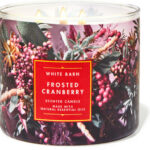Candles
CANDLE 101: Guide to Burning Your Candle Properly (Ultimate Guide)
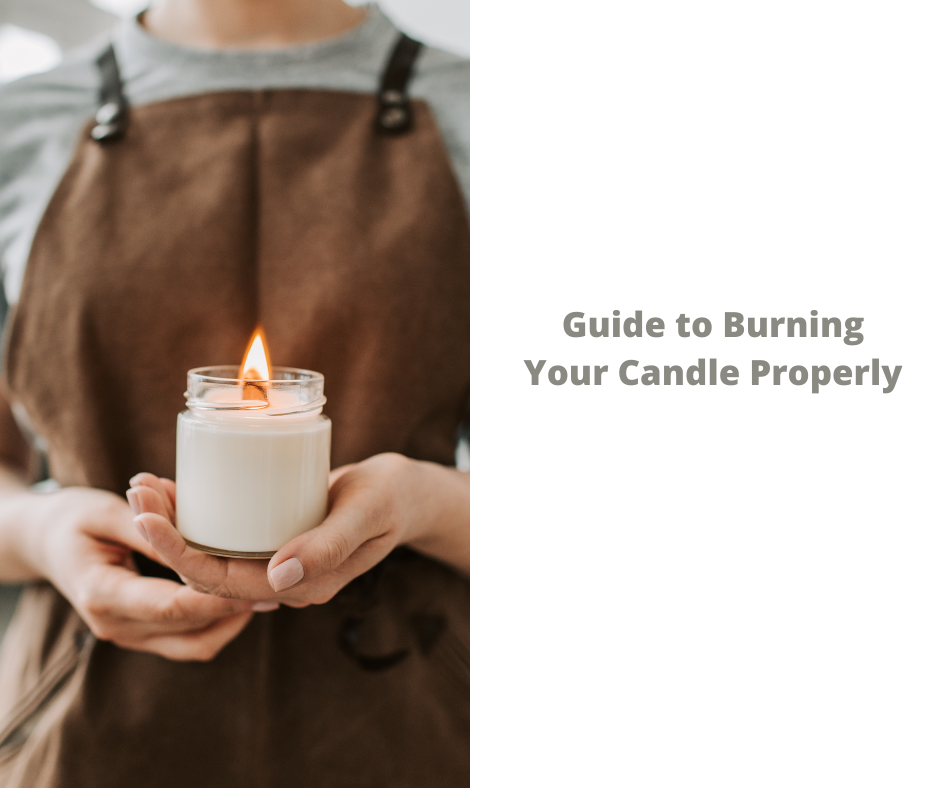
If you want to set a calm or cozy mood with candles, it’s important to know the proper way to burn them. Check out this quick guide to candle basics to improve your candle-burning experience!
The first thing you need to do is choose the right candle. Ensure the wick is made of natural fibers like cotton or linen and that the wax is of good quality. Once you have your candle, trim the wick before you light it. This will help the candle burn evenly. Remember always be careful when burning candle’s. The size of the candle varies the danger stays the same, always be careful and light it for about 3 to 4 hours the first time you burn it.
Guide to Burning Your Candle Properly (Ultimate Guide)
When you’re ready to light your candle, ensure it’s in a safe place where it won’t be knocked over. Then, use a wick trimmer or long lighter to light the wick at the base. Allow the flame to catch and then blow it out so that only the wick is lit.

Now it’s time to enjoy your candle! The general rule is to burn your candle for an hour for each inch of diameter. So, if you have a 4-inch diameter candle, you should burn it for 4 hours at a time. This will help ensure that the wax melts evenly and liquefies completely.
Just be sure to keep an eye on your candle while it’s burning. Never leave a lit candle unattended! While enjoying your candle, extinguish the flame by gently blowing it out.
Following these simple steps, you can enjoy your candles safely and effectively!
We’re All Burning Candles Wrong
We’ve all been there- it’s the middle of a romantic dinner, the mood is perfect, and your date reaches for the candles. You watch horror as they grab the lighter and start tilting the flame towards the wick, thinking, “No, no! Don’t do it!”
But it’s too late, they’ve already set the candle ablaze, and now the entire restaurant can smell like singed hair.
Why does this happen? Because we’ve all been burning candles wrong. The correct way to light a candle is by briefly touching the wick to the flame, then allowing it to self-extinguish.
This will heat the wax around the wick, making it easier for the candle to stay lit. So next time you’re setting the mood, remember to light your candles with a quick touch, not a long hold. Your date (and your nose) will thank you.
What Makes a Candle Flame?
A burning candle is a classic example of a fuel-oxidizer reaction. The heat from the flame melts the wax near the wick, vaporizing the liquid wax. Vaporized molecules are then drawn into the flame, reacting with oxygen from the air to create heat, light, water vapor (H2O), and carbon dioxide (CO2).

The heat generated by this reaction melts more wax, which is then drawn up into the flame, keeping the Candle burning. For a candle to burn, there must be a constant supply of fresh oxygen to support the combustion reaction. That’s why you often see candles flickering in a drafty room-the. Draft decreases the amount of oxygen available to the flame, causing it to flicker or go out altogether.
What Does “Candle Tunneling” Mean?
When a candle “tunnels”, it means that the wick is only burning the wax near the wick. This results in a longer burn time because less wax is consumed. However, it also means that less wax is available to be melted and drawn up the wick, so the flame may start to flicker and eventually go out if left unchecked.
Candle tunneling can be prevented by ensuring that the wick is trimmed to the correct length and with enough wax in the container to submerge the wick. If a candle has already started to tunnel, you can try tilting it so that the molten wax runs towards the unburned areas or gently heating the wax with a hair dryer to encourage it to flow evenly.
Why Does Tunneling Happen?
When you burn a candle, the flame’s heat melts the wax near the wick. This liquid wax is then drawn up the wick by capillary action. The flame’s heat vaporizes the liquid wax (turns it into a hot gas) and starts to break down the hydrocarbons into molecules of hydrogen and carbon. These vaporized molecules are drawn up into the flame, where they react with oxygen from the air to create heat, light, water vapor (H2O), and carbon dioxide (CO2).
The problem with tunneling is that it can happen when you burn a luxury candle for the first time. When you burn a candle, the flame’s heat melts the wax near the wick. This liquid wax is then drawn up the wick by capillary action. The flame’s heat vaporizes the liquid wax (turns it into a hot gas) and starts to break down the hydrocarbons into molecules of hydrogen and carbon. These vaporized molecules are drawn up into the flame, where they react with oxygen from the air to create heat, light, water vapor (H2O), and carbon dioxide (CO2).
The problem with tunneling is that it can happen when you burn a luxury candle for the first time. The heat from the flame melts the wax around the wick, but because the wax is solidifying as it cools, it can’t be drawn up into the flame as quickly. This causes the liquid wax to pool around the wick, and eventually, the flame will start to flicker and go out.
There are a few ways to prevent candle tunneling. The first is to ensure that the wick is trimmed to the correct length. The second is to provide enough wax is in the container to submerge the wick. And finally, if a candle has already started to tunnel, you can try tilting it so that the molten wax runs towards the unburned areas or gently heating the wax with a hair dryer to encourage it to flow evenly.
Are Scented Candles Toxic?
Ah, candles. The perfect way to set the mood, fill your home with a pleasant aroma, and… poison yourself and your loved ones? That’s right, folks – those scented candles you so enjoy may be slowly killing you.
But don’t worry, there’s an easy way to avoid this potentially fatal mistake: don’t use scented candles. Or, if you just can’t give up that jasmine-scented candle from Bath & Body Works, at least make sure it’s adequately ventilated when you use it.

The danger of scented candles is that they’re made with synthetic fragrances. These fragrances are made up of many chemicals, many of which are toxic. When you burn a scented candle, these chemicals are released into the air, where everyone in the room can inhale them. Inhaling these chemicals has been linked to various health problems, including headaches, dizziness, and asthma.
In some cases, they can even cause cancer. So if you want to keep your family safe, ditch the scented candles and opt for unscented ones instead. Your lungs will thank you for it.
Are Soy Candles Toxic?
What’s the big deal with soy candles? It seems like everyone is talking about them these days. And for a good reason – they’re eco-friendly, long-lasting, and smell great. But are they safe? Some people are concerned that soy candles may be toxic.
So, are soy candles safe? The short answer is yes. Soy candles are made from soybean oil, a natural, renewable resource. And while soybeans contain a small amount of mercury, the amount used in soy candles is negligible and not considered harmful.
Still not convinced? Here’s something else to consider – paraffin wax, commonly used in traditional candles, is a byproduct of petroleum refining. It can contain harmful chemicals like benzene and toluene, which can be released into the air when burned. On the other hand, Soy candles are non-toxic and help purify the air when burned.
So go ahead and enjoy your soy candle – it’s good for you and good for the environment!
Blowing out Your Candles
Blowing out a candle is more than just a way to make a wish. It’s also a powerful act of air pollution control. That’s right, every time you snuff out a flame, you do your part to improve air quality.
How? When you blow out a candle, you reduce the amount of particulate matter in the air. Particulate matter is made up of tiny particles that can be inhaled deep into the lungs, where they can cause respiratory problems. So, by blowing out candles, you’re helping to reduce the amount of particulate matter in the air and improve air quality. Not bad for something that’s usually seen as a simple act of a birthday celebration.
What Happens when Candle Is Burnt?
When a candle is burnt, the flame’s heat melts the wax near the wick. This liquid wax is drawn up the wick by capillary action. The flame’s heat vaporizes the liquid wax (turns it into a hot gas) and starts to break down the hydrocarbons into molecules of hydrogen and carbon. These vaporized molecules are drawn up into the flame, where they react with oxygen from the air to create heat, light, water vapor (H2O), and carbon dioxide (CO2).
Why Can’t You Burn Candles for More than 4 Hours?
You can’t burn candles for more than 4 hours because they are made of wax, and when the wax burns, it produces heat. If the candle is left unattended, the heat can build up and cause a fire.
How Do You Properly Burn a Candle?
To properly burn a candle, you must ensure that the wick is trimmed to 1/4 inch before each use. This will help prevent the flame from getting too big and soot forming on the glass. You also want to make sure that the candle is in a draft so that the flame doesn’t go out.
How Long Should You Burn a Candle?
You should burn a candle for about 1 hour for every inch in diameter. For example, if you have a 4-inch diameter candle, you should burn it for about 4 hours. This will help ensure that the candle is burned evenly and doesn’t tunnel.
When you first light a candle, allow it to burn until the wax melts to the edge of the glass. This will help prevent your candle from “tunneling.” Tunneling occurs when the flame only burns the wax in the middle of the candle, leaving a ring of unmelted wax around the edge.
To extinguish a candle, use a snuffer or dip the wick into the melted wax. DO NOT blow out a candle, as this can cause the hot wax to splatter.
Burning a candle is a simple way to enjoy its fragrance and ambiance. But it’s essential to do so safely. Use these tips to help you burn your candles properly.
What Actually Burns in A Candle?
The element that burns in a candle is made of hydrocarbons. Hydrocarbons are molecules consisting of both nitrogen and chlorine. The most common hydrocarbon is methane (CH4). Methane is the main constituent of natural gas. Other hydrocarbons include butane (C4H10), propane (C3H8), and acetylene (C2H2).
When you light a candle, the flame’s heat vaporizes the liquid wax near the wick. This vaporized wax then breaks down the hydrocarbons into hydrogen and carbon molecules. These vaporized molecules are drawn up into the flame, where they react with oxygen from the air to create heat, light, water vapor (H2O), and carbon dioxide (CO2).
The typical candle is made of paraffin wax, a petroleum product. However, there are also soy, beeswax, and other types of natural waxes.
Where Does the Wax in A Candle Go?
The wax in a candle doesn’t disappear. It just goes through a process called combustion. In combustion, the hydrocarbons in the wax are broken down into molecules of hydrogen and carbon. These molecules are then drawn up into the flame, reacting with oxygen from the air to create heat, light, water vapor (H2O), and carbon dioxide (CO2).
So, you see the burning of hydrogen and carbon when you look at a candle flame. The combustion of these molecules creates the light that you see.
How to Dispose of Used Candles
When you’re finished using a candle, dispose of it properly. The best way to do this is to cut the wick off the candle and put it in a sealed container. You can then put the container in the trash.
You should never throw a used candle in the garbage can without first cutting the wick off. The wick can continue to burn and start a fire.
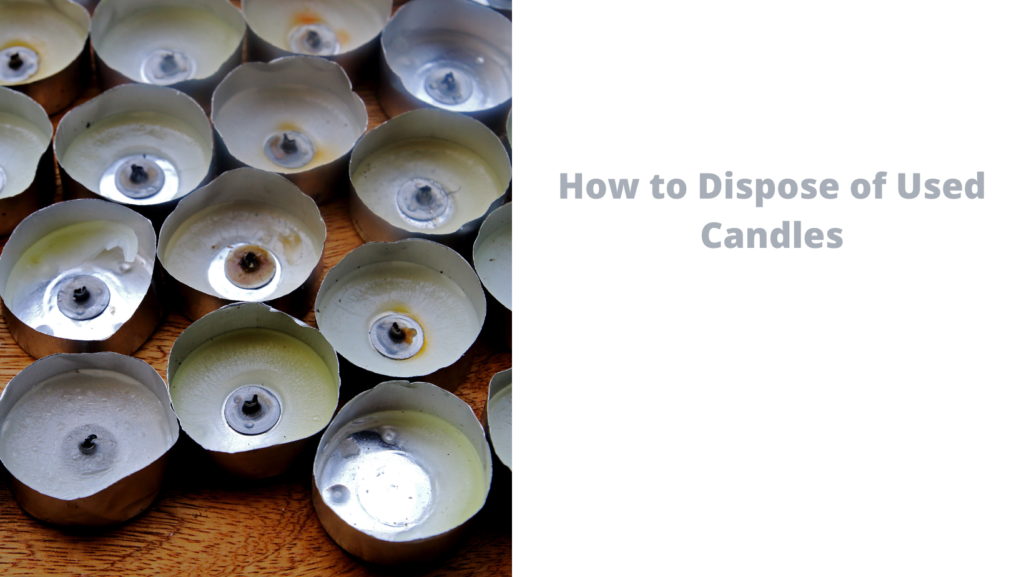
What Happens to Candle Wax when It Burns?
When you burn a candle, the flame’s heat vaporizes the liquid wax near the wick. This vaporized wax then starts to break down the hydrocarbons into hydrogen and carbon molecules. These vaporized molecules are drawn up into the flame, where they react with oxygen from the air to create heat, light, water vapor (H2O), and carbon dioxide (CO2).
So, when you look at a candle flame, you see the burning of hydrogen and carbon. The combustion of these molecules creates the light that you see.
How to Prevent Soot When Burning a Candle
If you notice soot buildup on your candles, you can do a few things to prevent it.
Trim the wick to about ¼ inch before each use. A longer wick will create a more significant flame and produce more soot.
Make sure the room you’re burning the candle in has good ventilation. Burning a candle in a stuffy room can cause soot to buildup on the sides of the jar.
Use a candle snuffer to extinguish the flame. Blowing out a candle can cause hot wax to splatter and create soot.
Choose a candle made of natural, lead-free wicks. Lead wicks can produce more soot than other types of wicks.
How Do Candles Run out Of Wax?
As a candle burns, the flame’s heat melts the wax near the wick. This liquid wax is then drawn up into the flame, vaporizing it and breaking it down into hydrogen and carbon molecules. These vaporized molecules are drawn up into the flame, where they react with oxygen from the air to create heat, light, water vapor (H2O), and carbon dioxide (CO2).
Over time, the amount of wax near the wick decreases as it’s drawn up into the flame. Eventually, there’s not enough wax left to sustain the flame, and the candle goes out.
Is Burning a Candle a Chemical or Physical Change?
When you burn a candle, the wax undergoes a chemical change. In this change, the hydrocarbons in the wax are broken down into molecules of hydrogen and carbon. These molecules are then drawn up into the flame, where they react with oxygen from the air to create heat, light, water vapor (H2O), and carbon dioxide (CO2).
So, when you look at a candle flame, you see the burning of hydrogen and carbon. The combustion of these molecules creates the light that you see.
What Is Candle Burning Called?
The burning of a candle is called combustion. In combustion, the hydrocarbons in the wax are broken down into molecules of hydrogen and carbon. These molecules are then drawn up into the flame, where they react with oxygen from the air to create heat, light, water vapor (H2O), and carbon dioxide (CO2).
Is Burning a Candle Unhealthy?
The burning of candles is generally not considered harmful to health. However, some people may be sensitive to the smoke and fumes produced by candles. If you’re concerned about the health effects of burning candles, it’s best to use unscented candles made of natural materials like beeswax or soy wax. You can also try using an electric candle diffuser, which doesn’t produce any smoke or fumes.
How Long Does a Candle Burn?
The average candle will burn for 4 to 8 hours. However, the size and type of candle you’re using can affect this. For example, a large candle made of beeswax will burn for longer than a small candle made of paraffin wax.
What Is the Safest Way to Burn a Candle?
The safest way to burn a candle is to use a glass jar or holder. This will help contain the flame and prevent hot wax from splattering. Make sure the room you’re burning the candle in has good ventilation, and trim the wick to about ¼ inch before each use. Extinguish the flame with a candle snuffer, and never leave a burning candle unattended.
What Happens if You Burn a Candle Too Long?
If you burn a candle for too long, the heat from the flame can cause the glass jar or holder to crack. This can be a fire hazard, so it’s important to extinguish the flame and allow the candle to cool before relighting it. You should also trim the wick to about ¼ inch before each use to prevent the flame from getting too big.
Can You Refill a Candle?
Yes, you can refill a candle. To do this, melt the wax from an old candle and pour it into a new glass jar or holder. To make a scented candle, you can add fragrance oil to the melted wax. Make sure the wick is centered in the jar before the wax cools, and trim it to about ¼ inch before lighting the candle.
What Is the Purpose of a Candle?
The purpose of a candle is to produce light. Candles were once the only light source at night, but now they’re mainly used for decoration or to create a relaxing atmosphere. Candles can also be used to celebrate special occasions, like birthdays and holidays.
How Do I Choose the Right Candle?
When choosing a candle, it’s important to consider its size, shape, and material. For example, a large candle made of beeswax will burn for longer than a small candle made of paraffin wax. Consider its color and scent if you’re looking for a decorative candle. If you want a candle that produces a lot of light, choose one with a large wick.
Is There a Difference Between Scented and Unscented Candles?
Yes, there is a difference between scented and unscented candles. Scented candles are made with fragrance oils, giving off a strong smell. Unscented candles don’t contain fragrance oils, so they don’t have a strong scent.
How Do You Light a Candle, so It Burns Evenly?
To light a candle so it burns evenly, hold a lighter at the base of the wick and wait for it to catch fire. Then, carefully tilt the candle until the melted wax pool reaches the edge of the wick. This will help the flame evenly distribute heat to the wax, preventing tunneling.
How Do You Keep Candles from Tunneling?
Tunneling occurs when the flame only melts the wax around the wick, causing the candle to burn down the middle. To prevent this, ensure the wick is trimmed to ¼ inch before each use. You can also try lighting the candle for a longer period so the melted wax pool reaches the edge of the jar or holder.
Why Is My Candle Making a Crackling Sound?
If your candle is making a crackling sound, it’s likely because the wick is too long. When the wick is too long, it can create a small flame that doesn’t produce enough heat to vaporize the wax. This causes the wax to melt and then solidify around the wick, making a crackling sound. To fix this, extinguish the candle and trim the wick to about ¼ inch before relighting it.
My Candle Is Smoking, What Should I Do?
If your candle is smoking, it’s likely because the wick is too long. When the wick is too long, it can create a small flame that doesn’t produce enough heat to vaporize the wax. This causes the wax to melt and solidify around the wick, which can cause the candle to smoke. To fix this, extinguish the candle and trim the wick to about ¼ inch before relighting it.
My Candle Won’t Stay Lit, What Should I Do?
If your candle won’t stay lit, it’s likely because the wick is too short. When the wick is too short, it can’t create a large enough flame to vaporize the wax. This causes the wax to extinguish the flame. To fix this, extinguish the candle and trim the wick to about ¼ inch before relighting it.
Should You Put Candles in Your Room?
Candles can be used as a decoration in any room. However, if you’re looking to create a relaxing atmosphere, it’s best to put them in a room where you’ll spend most of your time, such as the living room or bedroom. You should also avoid placing candles near flammable objects, such as curtains or bedding.
Can You Put a Candle on The Floor?
Yes, you can put a candle on the floor. However, you should avoid placing candles near flammable objects, such as curtains or bedding. You should also make sure the candle is in a stable and level position so it doesn’t tip over.
Is It Safe to Leave Candles Burning Unattended?
No, it’s not safe to leave candles burning unattended. Candles should always be supervised to prevent fires. If you’re going to be away from the candle for an extended period, extinguish it and allow it to cool before leaving the room.
What Surfaces Are Safe for Candles?
Any non-flammable surface and level is safe for candles. Examples of safe surfaces include tables, shelves, and candle holders. You should avoid placing candles on flammable surfaces, such as carpets or curtains.
My Candle Is melting funny, What’s Wrong With It?
If your candle is melting funny, it’s likely because the wick is too long. When the wick is too long, it can create a small flame that doesn’t produce enough heat to vaporize the wax. This causes the wax to melt and then solidify around the wick, which can cause the candle to melt funny. To fix this, extinguish the candle and trim the wick to about ¼ inch before relighting it.
What Can I Place a Candle On?
Any non-flammable surface and level is safe for candles. Examples of safe surfaces include tables, shelves, and candle holders. You should avoid placing candles on flammable surfaces, such as carpets or curtains.
I Keep Blowing Out My Candle But It Won’t Stay Lit, What’s Wrong?
If you’re having trouble keeping your candle lit, it’s likely because the wick is too short. When the wick is too short, it can’t create a large enough flame to vaporize the wax. This causes the wax to extinguish the flame. To fix this, extinguish the candle and trim the wick to about ¼ inch before relighting it.
I Dropped My Candle and the Wax Spilled, What Should I Do?
If the wax from your candle spills, allow it to harden before attempting to clean it up. Once the wax is hard, you can scrape it off with a blunt object, such as a butter knife. You can then wipe the area clean with a damp cloth.
I Think My Candle Is Damaged; what Should I Do?
If you think your candle is damaged, it’s best to discard it and get a new one. Candles are made of flammable materials, so they must be cautious when using them. If you’re unsure if your candle is damaged, it’s best to err on caution and get a new one.
How Should I Store My Candles?
Candles should be stored in a cool, dry place. Candles made of natural materials, such as beeswax or soy wax, can melt in warm temperatures.
Can You Burn Candles on Quartz Countertops?
Yes, you can burn candles on quartz countertops. However, you should avoid placing candles near flammable objects, such as curtains or bedding. You should also make sure the candle is in a stable and level position so it doesn’t tip over.
Is It Safe to Use Candles While Sleeping?
No, it’s not safe to use candles while sleeping. Candles should always be supervised to prevent fires. If you’re going to be away from the candle for an extended period, extinguish it and allow it to cool before leaving the room.
Can I Burn a Candle on Glass?
Yes, you can burn candles on glass. However, you should avoid placing candles near flammable objects, such as curtains or bedding. You should also make sure the candle is in a stable and level position, so it doesn’t tip over.
I’m Jane and I love candles. I have candles everywhere in my house–in every room, on every surface. I love the smell of candles, and I love how they make my place feel warm and cozy.
Candles are really important to me. They help me relax and de-stress after a long day. They remind me of happy memories, and they make me feel calm and peaceful. I can’t imagine my life without candles!
Candles
What Is Candle Power

Have you ever thought about the enchanting glow given off by a basic candle? It’s fascinating to witness how a small flame can light up a room, providing both warmth and light.
At our service, we believe in understanding the power behind every flicker, and that’s why we’re here to shed light on the concept of candle power.
Candle power, in simple terms, refers to the brightness of a candle. But it’s more than just a measure of illumination; it’s a beacon of comfort, ambiance, and guidance.
In this guide, we’ll explore the historical origins, scientific measurements, and practical applications of candle power.
So, let’s embark on this enlightening journey together and uncover the secrets behind the captivating world of candle power.
Key Takeaways
- Candle power is a measurement unit that quantifies the brightness of a light source, allowing for comparisons between different light sources.
- It is used to determine the intensity of light emitted by a candle or any other artificial light source, and understanding candle power helps in providing adequate lighting for various tasks and environments.
- Factors affecting candle power include the wattage of the light source, the distance from the source, and obstructions or reflections in the environment.
- Candle power played a crucial role in the development of electric lighting, influenced architectural design and artistic expression, and continues to be important in various practical applications such as photography and automotive lighting systems.
The Definition of Candle Power
Candle power is a measurement unit that quantifies the brightness of a light source. It’s used to determine the intensity of light emitted by a candle or any other artificial light source. Candle power units, also known as candela, are the standard metric used to measure the luminous intensity of a light bulb or lamp.
The candle power measurement allows us to compare the brightness of different light sources and choose the most suitable one for our needs. By understanding the candle power of a light source, we can ensure that we provide adequate lighting for various tasks and environments.
Now that we’ve covered the definition of candle power, let’s move on to the historical origins of this measurement unit.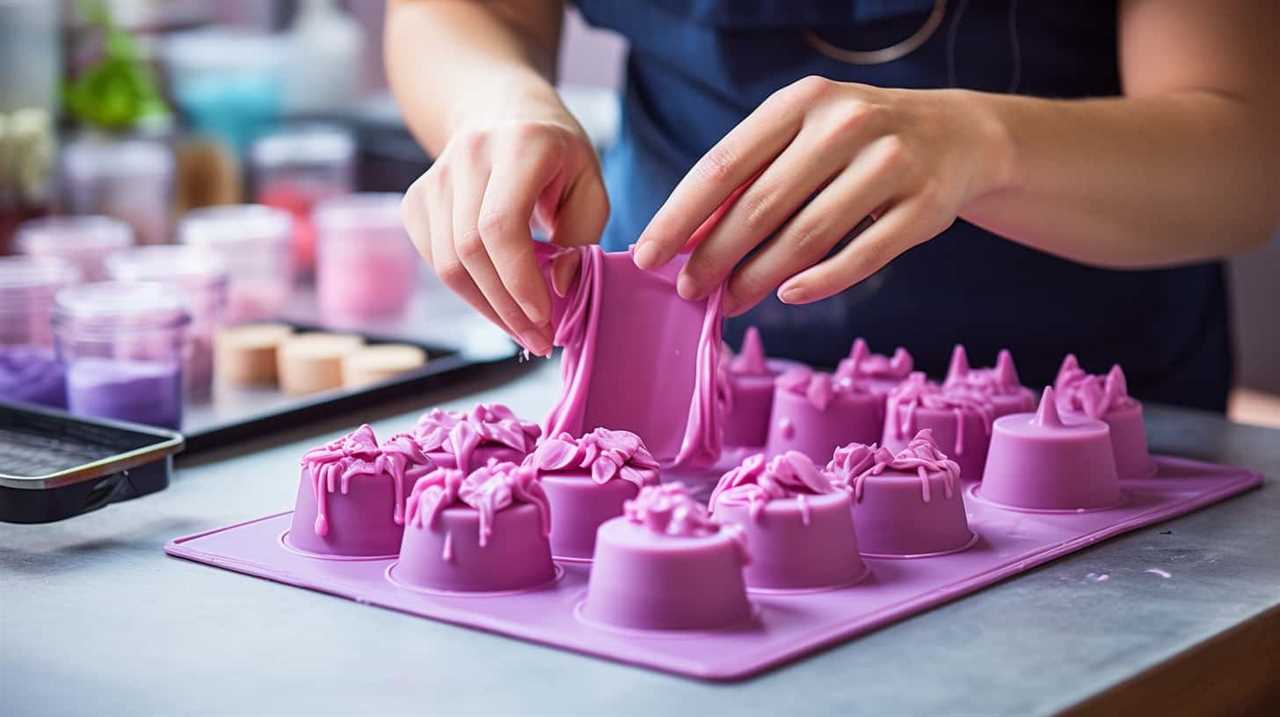
Historical Origins of Candle Power
Continuing from our previous discussion on the definition of candle power, let’s delve into the historical origins of this measurement unit. Understanding the invention timeline and cultural significance of candle power can provide valuable insights into its development and usage.
- Invention Timeline:
- 1838: Scottish inventor James David Forbes introduced the concept of candle power as a measure of light intensity.
- 1860s: British physicist Sir William Thomson (Lord Kelvin) refined the measurement by using a standard sperm candle.
- 1893: The International Commission on Illumination (CIE) established the formal definition of candle power.
- Cultural Significance:
- Candle power allowed for standardized measurement of light sources, enabling accurate comparisons and advancements in lighting technology.
- It played a crucial role in the development of electric lighting, as candle power measurements provided a benchmark for brightness.
- Candle power measurements also influenced architectural design and created new possibilities for artistic expression through lighting.
Understanding the historical origins of candle power helps us appreciate the progress made in lighting technology and its impact on various aspects of our lives.
How Candle Power Relates to Brightness
As we explore the concept of candle power further, it is important to understand how this measurement relates to the overall brightness of a light source. Candle power is a unit that quantifies the light output of a source, specifically the amount of light emitted in all directions. When we talk about candle brightness, we are essentially referring to the intensity or strength of the light produced. To better grasp this relationship, let’s take a look at the table below:
| Candle Power | Light Output (Lumens) |
|---|---|
| 1 | 12.57 |
| 10 | 125.7 |
| 100 | 1257 |
In the table, you can see that as the candle power increases, so does the light output. For instance, a light source with a candle power of 100 will emit approximately 1257 lumens of light. This means that the higher the candle power, the brighter the light source. Understanding this correlation can help us make informed decisions when choosing lighting options to meet our specific needs.
The Science Behind Measuring Candle Power
When it comes to measuring candle power, there are various techniques used to determine light intensity. These techniques include:
- Photometry
- Radiometry
- Spectrophotometry
Factors that affect candle power include:
- The wattage of the light source
- The distance from the source
- Any obstructions or reflections in the environment.
Understanding these measurement techniques and factors is crucial in accurately assessing the brightness of a light source.
Light Intensity Measurement Techniques
To understand the science behind measuring candle power, we’ll explore various light intensity measurement techniques. These techniques are essential in determining the amount of light emitted by a source, and they play a crucial role in many industries and applications.
Here are three commonly used techniques:
- Photometry: This technique measures the intensity of visible light by using a photometer, which compares the light output of a source to a standard reference. It provides accurate measurements in terms of luminous intensity and is widely used in lighting design and evaluation.
- Radiometry: Radiometers are used to measure the total power of light, including both visible and non-visible wavelengths. This technique is particularly useful in applications that require measuring the total light energy emitted by a source, such as solar energy studies.
- Spectroradiometry: Spectroradiometers measure the intensity of light at different wavelengths, providing a detailed spectral distribution. This technique is widely used in colorimetry, where the color properties of light sources are analyzed and evaluated.
Factors Affecting Candle Power
Let’s delve into the factors that impact candle power, shedding light on the science behind measuring this crucial light intensity.
When it comes to measuring candle power, there are several key factors to consider. One important factor is the type and condition of the light source. For example, a new and well-maintained bulb will produce a higher candle power than an old or damaged one.
Another factor is the distance between the light source and the object being illuminated. As the distance increases, the candle power decreases.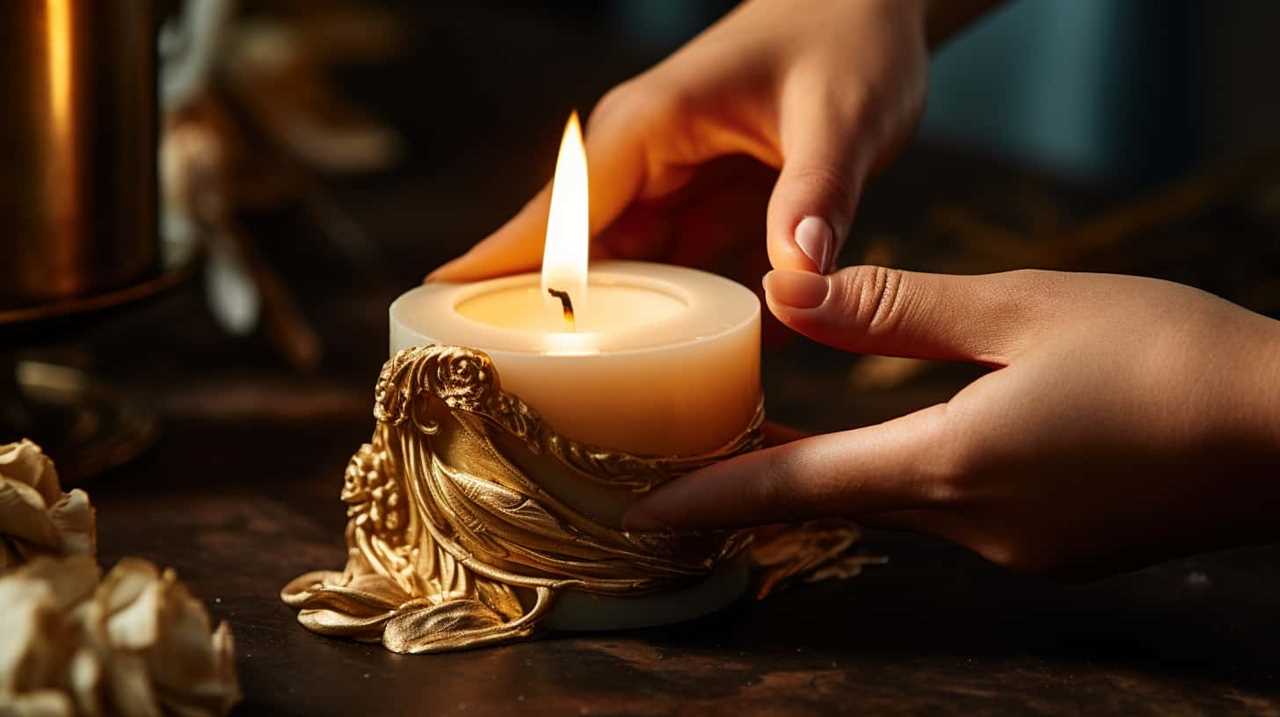
Additionally, the angle at which the light is emitted plays a role in candle power. Narrower angles tend to result in higher candle power, while wider angles lead to lower values.
These factors, among others, are essential to consider when using measurement techniques to determine candle power accurately.
Candle Power Vs Lumens: Understanding the Difference
As we delve into the comparison between candle power and lumens, it becomes clear that understanding the difference is essential. When it comes to measuring the brightness of a light source, lumens are the preferred unit of measurement. Here are three key differences between candle power and lumens:
- Lumen Measurement: Lumens measure the total amount of visible light emitted by a light source. It takes into account the entire range of visible light, making it a more accurate indicator of brightness.
- Candle Power Formula: Candle power, on the other hand, measures the intensity of light in a specific direction. It’s calculated by dividing the total luminous flux by the solid angle in steradians.
- Practical Application: Lumens provide a more practical measurement for everyday use. They help us understand how bright a light source will appear to the human eye, while candle power is more suitable for specialized applications like spotlighting.
Understanding the difference between candle power and lumens allows us to make informed decisions when choosing lighting options for our specific needs.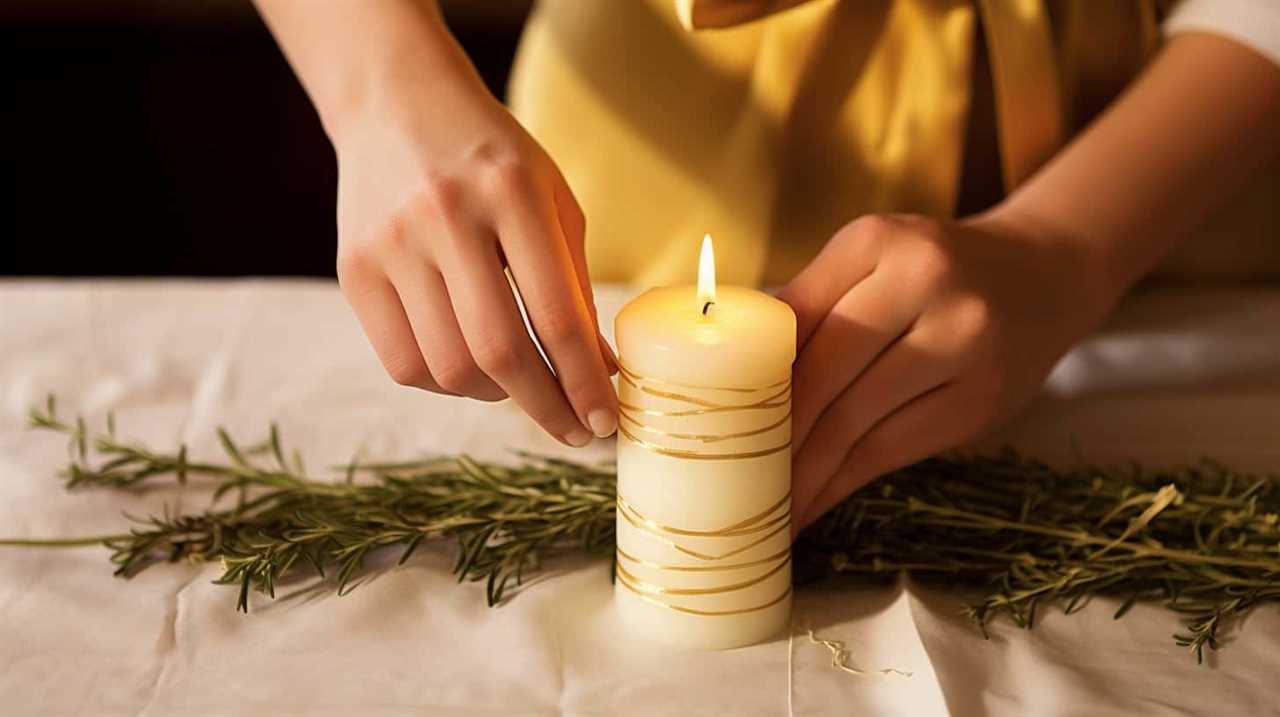
Factors Affecting Candle Power
Although there are several factors that can affect candle power, one important factor to consider is the type of light source being used. Different light sources produce varying levels of candle power due to their unique characteristics.
For example, incandescent bulbs typically have a higher candle power compared to fluorescent or LED bulbs. The quality and condition of the light source can also impact its candle power. Factors such as age, cleanliness, and maintenance can affect the performance of the light source and subsequently its candle power.
Measurement techniques play a crucial role in determining candle power accurately. Using a light meter, the intensity of the light emitted by the source can be measured, providing a quantitative value for candle power.
Practical Applications of Candle Power
Considering the factors that affect candle power, measuring the intensity of light emitted by a source using a light meter provides a quantitative value for assessing its candle power. Understanding the practical applications of candle power can help us serve others better, especially in fields like photography and automotive lighting. Here are three key applications: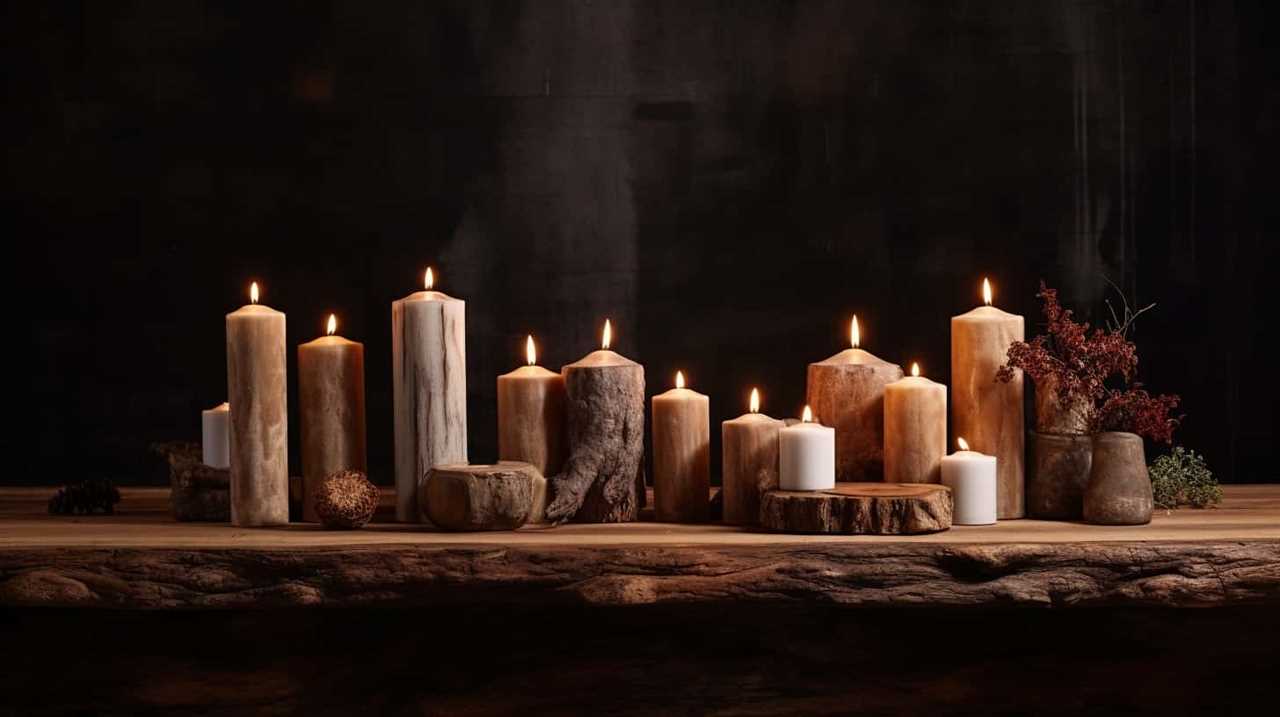
- Candle power in photography: Knowing the candle power of different light sources allows photographers to control the lighting conditions and achieve the desired effects in their photos. Whether it’s studio lighting or outdoor shoots, candle power helps determine the ideal lighting setup for capturing stunning images.
- Candle power in automotive lighting: The candle power of headlights and other automotive lighting systems directly affects visibility on the road. By ensuring a high candle power, drivers can enhance safety by providing optimal illumination and reducing the risk of accidents, especially in low-light or adverse weather conditions.
- Overall illumination assessment: Candle power measurements play a crucial role in assessing the overall lighting conditions in various settings. From evaluating the effectiveness of lighting in commercial spaces to ensuring proper illumination in public areas, candle power measurements aid in creating comfortable and safe environments for everyone.
Understanding the practical applications of candle power allows us to make informed decisions and optimize lighting for different purposes, ultimately serving others by enhancing their experiences in photography and ensuring safety on the roads.
Frequently Asked Questions
How Does Candle Power Affect the Visibility of a Light Source?
The effect of candle power on brightness and the impact of candle power on visibility are closely related. Higher candle power results in greater brightness, which in turn improves the visibility of a light source.
Can Candle Power Be Used to Measure the Efficiency of Different Light Sources?
Candle power can be used to measure the efficiency of different light sources. By comparing the candle power, we can determine the impact on energy consumption, helping us make informed choices.
Are There Any Safety Concerns Related to High Candle Power Light Sources?
Safety concerns may arise with high candle power light sources due to the risks associated with intense heat and potential fire hazards. It is essential to handle such sources with caution and ensure proper ventilation to prevent accidents.
How Does Candle Power Compare to Other Units of Measurement for Light Intensity, Such as Lux or Foot-Candles?
When comparing light intensity, candle power is like a bright star guiding our way. It offers advantages in lighting design, allowing us to measure and understand the power of light in a concise and informative manner.
Can Candle Power Be Used to Determine the Lifespan of a Light Bulb or Lamp?
Candle power is a unit of measurement for light intensity. It can’t be used to determine the lifespan of a light bulb or lamp. Factors affecting candle power include distance, reflectance, and the wattage of the light source.
Conclusion
In conclusion, understanding candle power is essential for determining the brightness of a light source. By measuring the intensity of light emitted from a single candle, candle power provides a standardized unit of measurement.
While it may seem outdated compared to the more commonly used lumens, candle power still holds value in certain applications.
So, next time you’re in a dark room, remember that a little knowledge about candle power can shed light on the situation.
I’m Jane and I love candles. I have candles everywhere in my house–in every room, on every surface. I love the smell of candles, and I love how they make my place feel warm and cozy.
Candles are really important to me. They help me relax and de-stress after a long day. They remind me of happy memories, and they make me feel calm and peaceful. I can’t imagine my life without candles!
Candles
What Is the Melting Point of Candle Wax

Wondering about the specific temperature at which candle wax melts? You’re in for a treat as we have the answer right here!
Understanding the melting point of candle wax is crucial for those who want to create the perfect candles for their loved ones or customers. Different types of candle wax have different melting points, and knowing these points can make a big difference in the quality of your candles.
For instance, let’s take the example of paraffin wax. Its melting point is around 130 to 140 degrees Fahrenheit. By understanding and testing the melting points of various waxes, you can ensure that your candles burn evenly and last longer.
So, let’s dive into the fascinating world of candle wax melting points and discover how it can elevate your candle-making skills!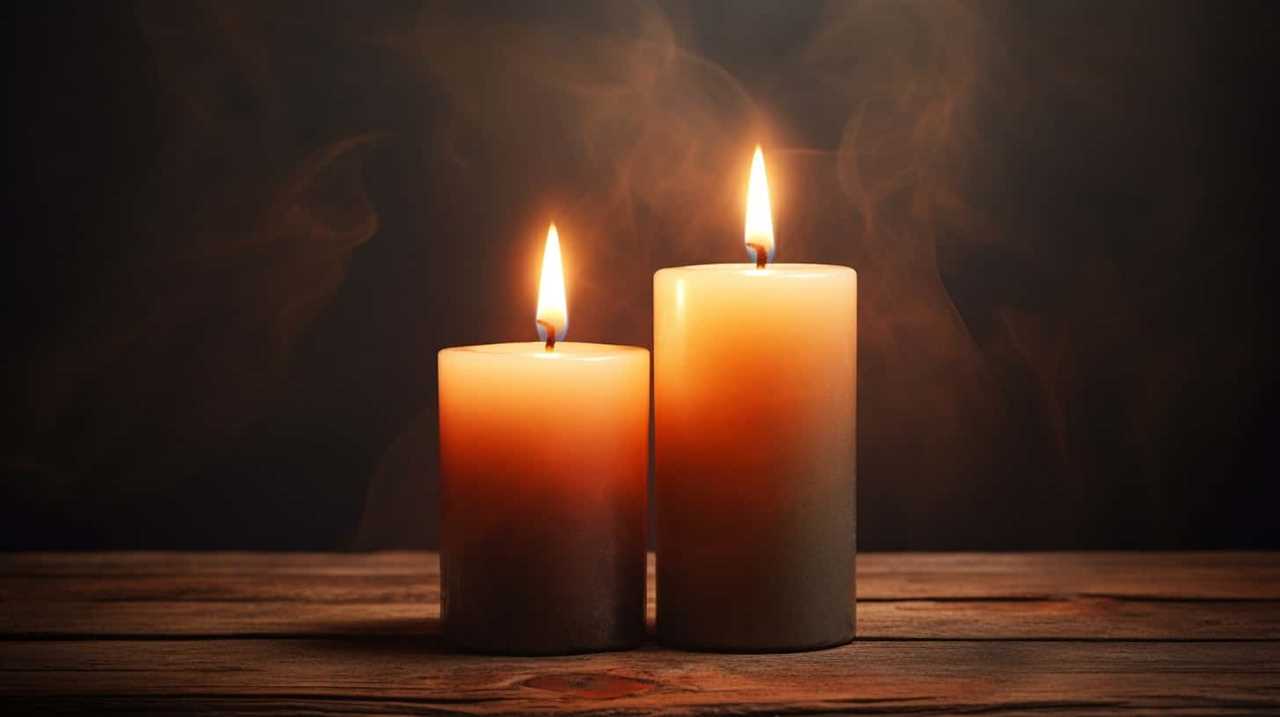
Key Takeaways
- The melting point of candle wax is the temperature at which it transitions from a solid to a liquid state.
- The melting point is important in determining the quality, performance, and behavior of candles.
- Different types of candle wax have different melting points, which affect factors such as burn time and fragrance release.
- Factors that influence the melting point of candle wax include the composition of the wax, heat source, impurities, additives, and container size and shape.
What Is Melting Point
The melting point is the temperature at which a substance transitions from a solid to a liquid state. It’s an important characteristic of a substance, as it helps determine its physical properties and behavior.
Temperature control is crucial in various industries where accurate melting points are required for manufacturing processes. For example, in the pharmaceutical industry, knowing the melting point of a drug substance is essential to ensure its stability and effectiveness.
Impurities can have a significant impact on the melting point of a substance. Even small amounts of impurities can lower the melting point, affecting the integrity and quality of the final product. Therefore, maintaining proper temperature control and minimizing impurities are vital in order to ensure consistent and reliable results in various applications.
Importance of Melting Point for Candles
In our experience with candle making, we’ve found that the melting point of candle wax plays a crucial role in determining the quality and performance of the final product. The importance of temperature control can’t be overstated when it comes to candle making.
When the wax is melted at the correct temperature, it ensures that the fragrance oils are properly dispersed and that the candle burns evenly and cleanly. If the wax is overheated, it can result in poor scent throw and a weaker fragrance. On the other hand, if the wax isn’t heated enough, the candle may not burn properly or may have a shorter burn time.
Additionally, the melting point of the wax can be affected by the use of additives, such as colorants or fragrance oils. These additives can alter the wax’s melting point, so it’s important to carefully consider their effects when formulating candle recipes.
Types of Candle Wax
When it comes to candle making, we rely on different types of candle wax depending on our specific needs and preferences. Here are four types of candle wax commonly used:
- Paraffin Wax: This petroleum-based wax is widely used due to its affordability and versatility. It has a high melting point, which makes it ideal for creating strong and long-lasting candles.
- Soy Wax: Made from soybean oil, this natural wax is a popular choice among environmentally conscious individuals. It has a lower melting point compared to paraffin wax, resulting in a slower and cleaner burn.
- Beeswax: Derived from bees, this natural wax is known for its sweet scent and golden hue. It has a higher melting point and produces a warm, soft glow when burned.
- Palm Wax: Made from palm oil, this renewable wax has a unique crystalline structure that gives candles a beautiful feathered appearance. It has a moderate melting point and provides excellent scent throw.
Understanding the differences between paraffin wax vs soy wax and beeswax vs palm wax allows us to choose the right type of candle wax for our specific needs, whether it’s for fragrance, sustainability, or aesthetic purposes.
Factors Affecting Melting Point
To understand the factors affecting the melting point of candle wax, we need to consider various elements that play a role in determining this characteristic.
One crucial factor is the composition of the candle wax. Different types of wax, such as paraffin, beeswax, or soy wax, have different melting points due to variations in their chemical composition. For example, paraffin wax has a lower melting point compared to beeswax, making it easier to melt.
Another factor that influences the melting point is the heat source. The temperature and intensity of the heat source can significantly affect the melting point of the wax. A higher heat source will increase the rate of heat transfer, causing the wax to melt at a lower temperature.
Therefore, understanding the candle wax composition and the influence of the heat source is essential in determining the melting point of candle wax.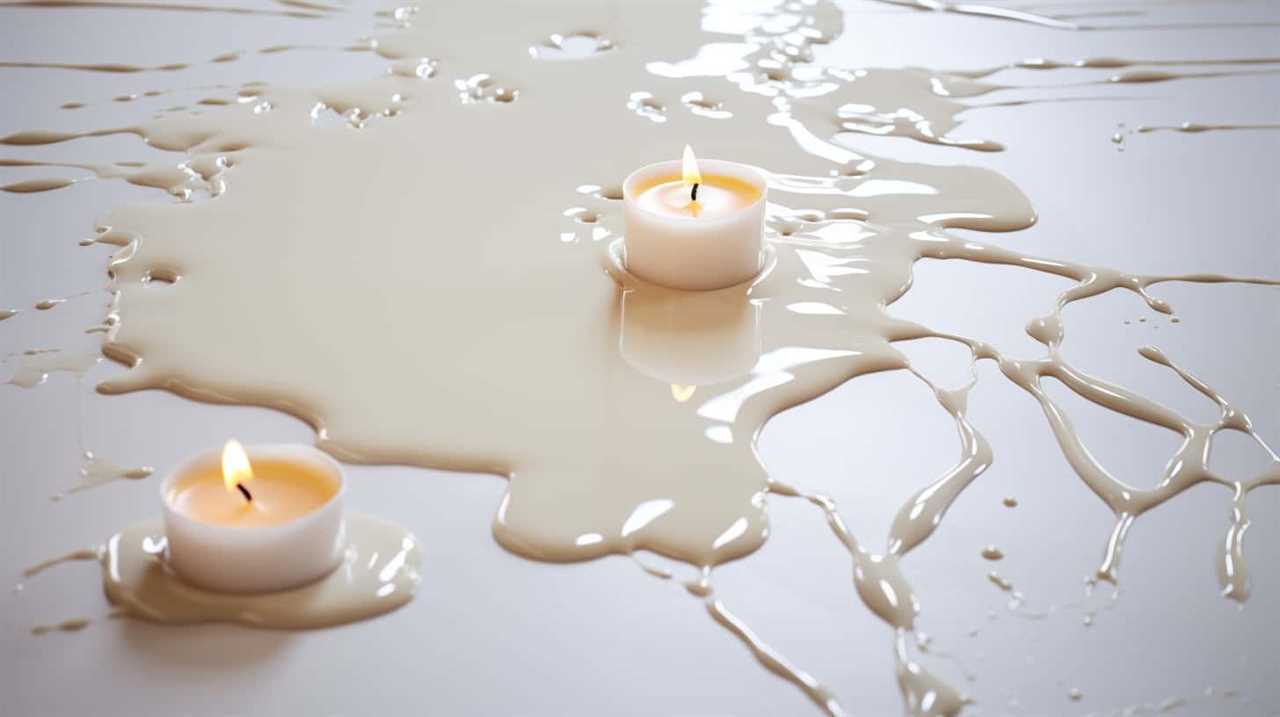
Paraffin Wax and Its Melting Point
When considering the melting point of paraffin wax, it’s important to analyze the factors that affect it. These factors include the molecular structure, purity of the wax, and any additives present.
Additionally, comparing the melting points of different waxes can provide valuable insights into their composition and applications.
Factors Affecting Melting Point
Our research has revealed several factors that influence the melting point of paraffin wax. These factors include:
- Impurities: The presence of impurities, such as additives or contaminants, can lower the melting point of paraffin wax. Higher purity wax tends to have a higher melting point.
- Crystalline Structure: The crystalline structure of paraffin wax can vary depending on factors like the length of the hydrocarbon chain. Waxes with longer chains tend to have higher melting points.
- Molecular Weight: The molecular weight of the wax molecules also affects the melting point. Higher molecular weight waxes generally have higher melting points.
- Temperature Range: The temperature range over which paraffin wax melts can vary depending on the specific formulation and purpose. Different types of paraffin waxes may have different melting points and melting temperature ranges.
Understanding these factors can help in selecting the appropriate paraffin wax for specific applications, ensuring optimal performance and usability.
Comparing Different Waxes
We will compare the melting point of paraffin wax to that of other waxes. Comparing melting points is important because it directly affects the performance of a candle.
Paraffin wax, which is derived from petroleum, has a melting point between 120°F and 160°F (49°C to 71°C). This relatively low melting point allows the wax to liquefy quickly when the candle is lit, ensuring a consistent and even burn. Paraffin wax also has a high fragrance capacity, making it a popular choice for scented candles.
Other waxes, such as beeswax and soy wax, have higher melting points. Beeswax melts between 144°F and 147°F (62°C to 64°C), while soy wax melts between 120°F and 180°F (49°C to 82°C). The melting point of a wax can impact the candle’s ability to release fragrance and its overall burn time.
Transitioning to the subsequent section, we’ll now explore soy wax and its melting point.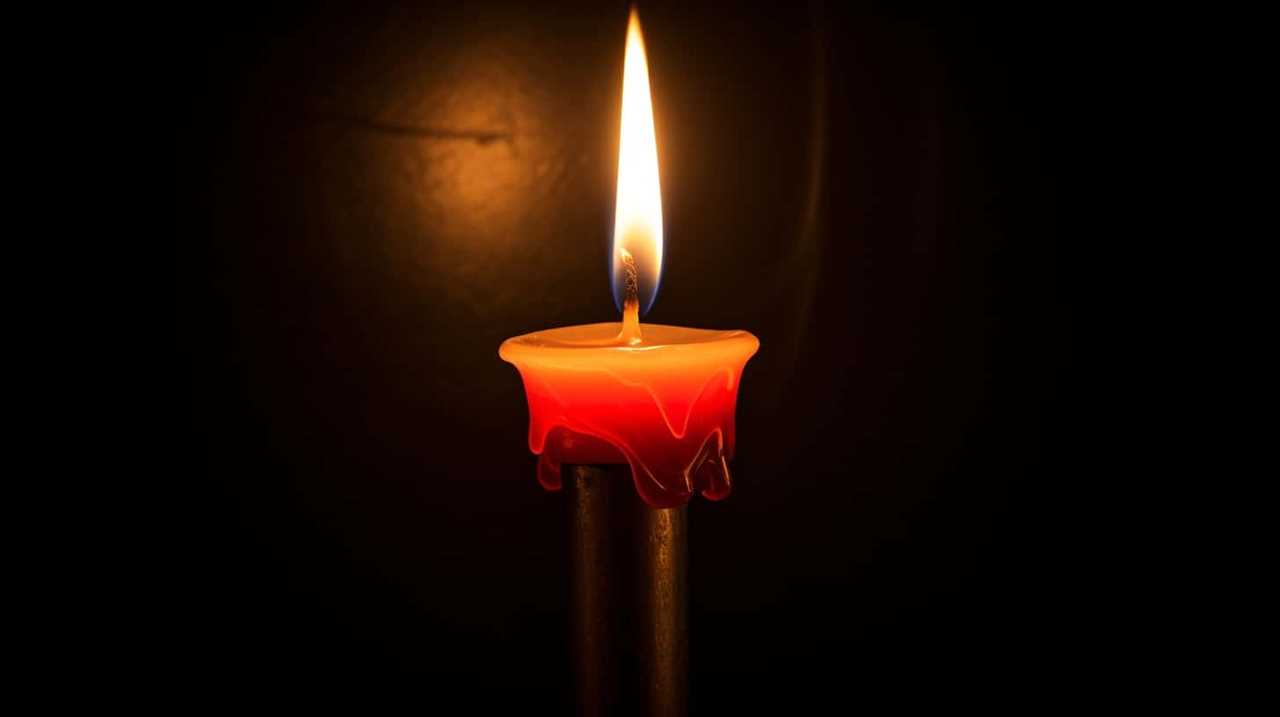
Soy Wax and Its Melting Point
Soy wax has a melting range of approximately 120 to 180 degrees Fahrenheit, making it a suitable choice for candle making.
The melting point of soy wax can be influenced by various factors such as the specific blend of oils used and any additives included.
When compared to other waxes, soy wax tends to have a lower melting point, allowing for a longer burning time and a more gradual release of fragrance.
Soy Wax Melting Range
Typically, soy wax melts at a relatively low temperature, often requiring frequent monitoring during the melting process.
Some key properties of soy wax that contribute to its melting range include:
- Low melting point: Soy wax has a melting point range of around 115 to 125 degrees Fahrenheit (46 to 52 degrees Celsius). This low melting point allows it to melt easily and evenly when exposed to heat.
- Slow cooling: Soy wax has the advantage of a slow cooling process, which results in a longer burning time for candles made from this wax.
- Clean burning: Soy wax is known for its clean and soot-free burn, making it a popular choice for those concerned about air quality.
- Compatibility with fragrance oils: Soy wax has a high fragrance load capacity, allowing it to hold and release scents effectively.
Understanding the melting range of soy wax is crucial for candle makers and enthusiasts to ensure proper melting and pouring techniques, ultimately resulting in high-quality candles.
Factors Affecting Melting
Frequently, candle makers and enthusiasts encounter various factors that influence the melting point of soy wax. These factors can have a significant impact on candle performance and efficiency.
One of the key factors affecting the melting point of soy wax is the type of additives used. Certain additives, such as stearic acid or vybar, can raise the melting point of the wax, making it more suitable for specific candle types or environments.
The purity of the soy wax also plays a role, as impurities can lower the melting point and affect the overall quality of the candle.
Additionally, the container size and shape can influence the melting point, as larger containers may require higher melting points to ensure proper scent throw and burn time.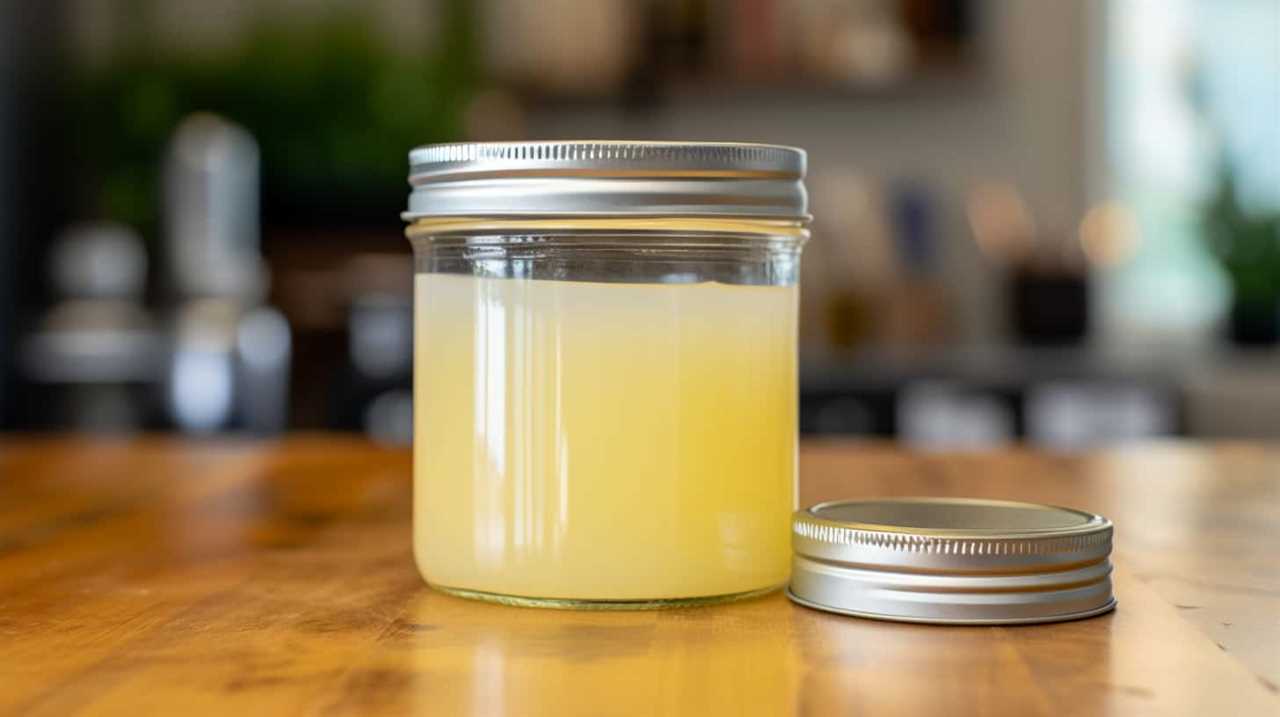
Comparing With Other Waxes
When comparing the melting point of soy wax to other waxes, we can see significant differences in their performance and suitability for various candle types and environments. Here are some key points to consider:
- Soy wax has a lower melting point compared to other waxes, typically ranging from 120-160°F (49-71°C).
- This lower melting point makes soy wax ideal for container candles, as it allows for a slower, more controlled burn.
- Soy wax has a longer burn time compared to other waxes, providing a longer-lasting candle experience.
- The lower melting point of soy wax also makes it easier to handle and work with during the candle-making process.
These differences in wax properties make soy wax a popular choice among candle makers looking for a versatile and high-quality wax option. Its unique melting point and performance characteristics contribute to its appeal in various candle-making applications.
Beeswax and Its Melting Point
In the article, we’ll explore the melting point of beeswax.
Beeswax, a natural wax produced by honeybees, is known for its unique properties and versatility in various applications.
When it comes to melting temperature, beeswax has a relatively low melting point compared to other waxes. The melting point of beeswax typically ranges between 144 to 147 degrees Fahrenheit (62 to 64 degrees Celsius).
This relatively low melting point makes beeswax an ideal choice for candles, as it allows for a slow and even burn. Additionally, the low melting point of beeswax makes it easy to work with in various crafts and skincare products.
Now, let’s move on to the next section where we’ll discuss palm wax and its melting point.
Palm Wax and Its Melting Point
Let’s delve into the melting point of palm wax, a commonly used wax in candle making, and explore its unique properties. Palm wax is derived from the oil palm tree and has gained popularity due to its eco-friendly nature.
Here are some key properties of palm wax and how it compares to other waxes in terms of melting point:
- Palm wax has a melting point ranging from 50 to 60 degrees Celsius.
- It has a higher melting point compared to soy wax, making it more suitable for warmer climates.
- Palm wax has excellent scent retention, allowing for a longer-lasting fragrance.
- Its smooth and creamy texture gives candles a luxurious appearance.
Understanding these palm wax properties and its melting point comparison lays a foundation for exploring blended waxes and their melting points.
Blended Waxes and Their Melting Points
When it comes to blended waxes and their melting points, there are several factors that come into play.
The composition of the blend, including the types and proportions of different waxes used, can greatly influence the melting point.
Additionally, additives or modifiers can also impact the melting point of the blend.
Factors Affecting Melting Points
We can explore the factors that influence the melting points of blended waxes by considering their composition and additives. Here are four key factors to consider:
- Molecular structure: The arrangement and size of molecules in the wax can affect its melting point. Waxes with longer hydrocarbon chains tend to have higher melting points, as the intermolecular forces between the molecules are stronger.
- Temperature control: The rate at which the wax is heated and cooled can also impact its melting point. Slow heating and gradual cooling can lead to a higher melting point, while rapid temperature changes can lower it.
- Additives: Certain additives, such as stearic acid or beeswax, can modify the melting point of the wax. These additives can either raise or lower the melting point depending on their chemical properties.
- Blending ratios: The proportions of different waxes in a blend can affect the overall melting point. Mixing waxes with different melting points can result in a blend with an intermediate melting point.
Understanding these factors is essential when comparing different wax blends and determining their suitability for specific applications.
Comparing Different Wax Blends
To compare different wax blends and their melting points, we can analyze the composition and additives of each blend. By understanding the properties of various waxes, we can determine the optimal melting temperature for different applications. The table below provides a comparison of three common wax blends used in candle making:
| Wax Blend | Composition | Melting Point |
|---|---|---|
| Paraffin | Petroleum-based | 130-150°F |
| Soy | Vegetable-based | 120-145°F |
| Beeswax | Natural beeswax | 144-147°F |
Paraffin wax, being petroleum-based, has a higher melting point compared to soy wax, which is derived from vegetable sources. Beeswax, a natural option, has the highest melting point among the three. When choosing a wax blend, it is important to consider the desired burning time, scent throw, and appearance. By comparing wax properties and their optimal melting temperatures, you can select the most suitable blend for your candle-making needs.
Practical Applications and Uses
For a variety of practical applications and uses, blended waxes with different melting points offer a range of options. These blends combine different types of waxes to create a desired melting point, enhancing their versatility and functionality.
Here are some practical uses of blended waxes and their benefits and drawbacks:
- Candle making: Blended waxes allow for customization of candle melting points, enabling the creation of candles that burn longer or have specific fragrance release profiles.
- Cosmetics and personal care products: Blended waxes are used in lip balms, lotions, and creams to provide desired consistency and stability.
- Adhesive and coating industries: Blended waxes with controlled melting points are used in adhesives and coatings to improve performance and durability.
- Food industry: Blended waxes find applications in food coatings, where specific melting points are required for proper adhesion and texture.
The benefits of blended waxes include enhanced flexibility, improved performance, and increased control over melting characteristics. However, drawbacks may include increased complexity in formulation and potential changes in other properties such as color or scent.
Testing and Determining Melting Point
Determining the melting point of candle wax involves conducting tests to measure the temperature at which it transitions from a solid to a liquid state. To achieve accurate results, various testing techniques can be employed. One common method is the capillary tube method, where a small sample of the wax is placed in a thin glass tube and heated slowly until it melts. The temperature is recorded when the first drop of liquid appears. Another technique is the hot stage microscopy, which involves observing the wax sample under a microscope while gradually increasing the temperature until melting occurs. This allows for precise determination of the melting point. To ensure temperature accuracy, calibrated thermometers and digital temperature probes can be used. These tools provide reliable and precise measurements, crucial for accurate melting point determination.
| Testing Technique | Description |
|---|---|
| Capillary Tube Method | A small sample of wax is heated slowly in a thin glass tube until it melts. The temperature is recorded when the first drop of liquid appears. |
| Hot Stage Microscopy | The wax sample is observed under a microscope while gradually increasing the temperature until melting occurs. This allows for precise determination of the melting point. |
Determining the melting point of candle wax requires careful attention to detail and accurate temperature measurements. By employing suitable testing techniques and ensuring temperature accuracy, one can obtain reliable results for this important property of candle wax.
Practical Applications of Melting Point in Candle Making
As we delve into the practical applications of the melting point in candle making, it becomes evident that understanding this property plays a crucial role in achieving desirable candle characteristics. The melting point of candle wax is a key factor in determining its burn time, scent throw, and overall performance.
Here are four practical applications of melting point in candle making:
- Control of burn time: By selecting a wax with a specific melting point, candle makers can regulate the rate at which the wax melts and therefore control the burn time of the candle.
- Scent release: Different fragrance oils have different flashpoints, which can affect the scent throw of a candle. By matching the melting point of the wax with the flashpoint of the fragrance oil, candle makers can optimize the release of the scent.
- Stability: Understanding the melting point allows candle makers to choose waxes that provide stability during the manufacturing process and when the candle is in use.
- Aesthetics: The melting point of wax can impact the appearance of a candle, influencing factors such as texture, color, and the formation of a desirable melt pool.
Frequently Asked Questions
How Does the Melting Point of Candle Wax Affect the Overall Burn Time of a Candle?
The melting point of candle wax directly influences the burn time and efficiency of a candle. By retaining heat at higher melting points, the wax burns more slowly and efficiently, resulting in a longer-lasting candle.
Can the Melting Point of Candle Wax Be Adjusted to Create Different Types of Candles, Such as Dripless or Scented Candles?
Yes, the melting point of candle wax can be adjusted to create different types of candles. This allows for the creation of dripless or scented candles, providing a more enjoyable and convenient experience for customers.
Are There Any Safety Concerns Associated With Using Candle Wax With a High Melting Point?
Safety precautions should be taken when working with candle wax with a high melting point. Proper temperature control is crucial to prevent burns or fires. It is important to handle the wax carefully and follow recommended safety guidelines.
How Does the Melting Point of Candle Wax Affect the Fragrance Throw of Scented Candles?
The melting point of candle wax directly affects the fragrance release and scent retention of scented candles. Higher melting points allow for longer burn times and better scent retention, resulting in a stronger and longer-lasting fragrance throw.
Can the Melting Point of Candle Wax Affect the Appearance or Texture of the Finished Candle?
The melting point of candle wax impacts its appearance and texture. A higher melting point results in a smoother texture and better moldability, while lower melting points can affect color and lead to a rougher finish.
Conclusion
In conclusion, understanding the melting point of candle wax is crucial for candle makers. By knowing the melting point, they can select the right wax for their desired candle characteristics. Factors like the type of wax and blending different waxes can also affect the melting point.
Testing and determining the melting point helps ensure the quality and performance of the candles. Overall, the melting point is a key factor in the art and science of candle making, like a compass guiding makers toward creating beautiful, long-lasting candles.
I’m Jane and I love candles. I have candles everywhere in my house–in every room, on every surface. I love the smell of candles, and I love how they make my place feel warm and cozy.
Candles are really important to me. They help me relax and de-stress after a long day. They remind me of happy memories, and they make me feel calm and peaceful. I can’t imagine my life without candles!
Candles
What Is a Sand Candle

Curious about what a sand candle is? Let us fill you in on all the details!
Sand candles are unique and beautiful creations that can bring joy and warmth to any space. They are handmade candles made by pouring melted wax into a mold filled with sand.
As the wax cools and hardens, it takes on the shape and texture of the sand, resulting in a stunning candle with a rustic and beachy feel.
Sand candles are not only a lovely addition to any home decor, but they also make thoughtful gifts for your loved ones.
So, if you’re ready to learn more about this delightful craft, let’s dive in and explore the world of sand candles together!
Key Takeaways
- Sand candles have a long history and cultural significance in coastal communities.
- Sand candles provide a sustainable alternative to traditional candle making.
- Candle molds, fragrance, wicks, sand, seashells, and stirring sticks are essential materials for making sand candles.
- Decorating techniques such as coloration, carving, and embellishments enhance the visual appeal of sand candles.
History of Sand Candles
One of the key aspects in understanding the history of sand candles is that they’ve been around for centuries. These candles hold a significant cultural significance in various parts of the world, particularly in coastal communities.
The art of sand candle making has been passed down through generations, with each culture adding its unique touch to the process. The process of making sand candles has evolved over time, adapting to the available resources and techniques.
However, with the increasing environmental impact of traditional candle making, sand candles provide a more sustainable alternative. By using sand as a mold and natural materials for the wick, sand candles reduce the carbon footprint associated with traditional candle making.
Now that we understand the cultural significance and environmental impact of sand candles, let’s explore the materials needed for sand candle making.
Materials Needed for Sand Candle Making
To make sand candles, we’ll need a few specific materials.
First, we’ll need candle molds, which come in various shapes and sizes. These molds will give our candles their unique shapes and designs.
Next, we’ll need candle fragrance to add a pleasant scent to our candles. There are many different fragrances available, such as lavender, vanilla, or citrus, allowing us to create candles that suit different preferences.
Additionally, we’ll need wicks, which are the strings that burn and provide light. We can choose from different types of wicks, depending on the size and type of candle we want to make.
With these materials in hand, we’re ready to embark on our sand candle making journey.
Step-By-Step Guide to Making a Sand Candle
Now let’s dive into the process of making a sand candle, starting with gathering the necessary materials.
To create a sand candle, you’ll need a few key items. Firstly, choose your wick type based on the size and shape of your candle. Cotton wicks are great for smaller candles, while larger ones may require braided or wooden wicks.
Next, select your sand colors. You can use a single color for a simple and elegant look or mix different shades for a vibrant and dynamic candle. Experiment with various combinations to find what speaks to you.
Once you have your wick and sand colors, you’re ready to move on to the next step – different techniques for decorating sand candles.
Different Techniques for Decorating Sand Candles
Now let’s explore various ways to enhance the beauty of sand candles through different decorating techniques.
One technique is sand candle coloration, where you can add vibrant and contrasting colors to your candles. You can achieve this by mixing colored sand with the regular sand before pouring it into the mold. This creates a stunning visual effect when the candle is lit.

Another technique is sand candle carving, which involves creating intricate designs on the surface of the candle using a carving tool or even a toothpick. This allows you to personalize your candles and add a touch of artistry.
These techniques not only make your sand candles visually appealing but also give them a unique and personal touch.
Now, let’s move on to the next section where we’ll discuss tips for achieving the perfect sand candle.
Tips for Achieving the Perfect Sand Candle
When it comes to achieving the perfect sand candle, there are a few key tips to keep in mind.
One important technique is proper wick placement, ensuring that it’s centered in the candle and extends to the bottom for even burning.
Another tip is to layer decorative sand in different colors or patterns to create a visually appealing design.
These techniques, when executed with precision, can help you create a stunning sand candle that will impress anyone who sees it.
Wick Placement Techniques
To achieve the perfect sand candle, we can enhance the wick placement techniques by using a subordinating conjunction.
The wick placement is a crucial step in candle making, as it determines how the flame will burn and the overall quality of the candle. When it comes to wick placement, it’s important to consider the size and shape of the container, as well as the type of wax being used.
Candle making tools such as wick holders or centering devices can be helpful in achieving a precise and even placement. Additionally, ensuring that the wick is securely attached to the bottom of the container will prevent it from moving or floating when the wax is poured.
Decorative Sand Layering
To create the perfect sand candle, we enhance the wick placement techniques and move on to discussing the importance of decorative sand layering. When it comes to beach themed centerpieces and unique candle holders, decorative sand layering plays a crucial role in creating a visually stunning and captivating sand candle.
Here are three key tips to achieve the perfect sand candle through decorative sand layering: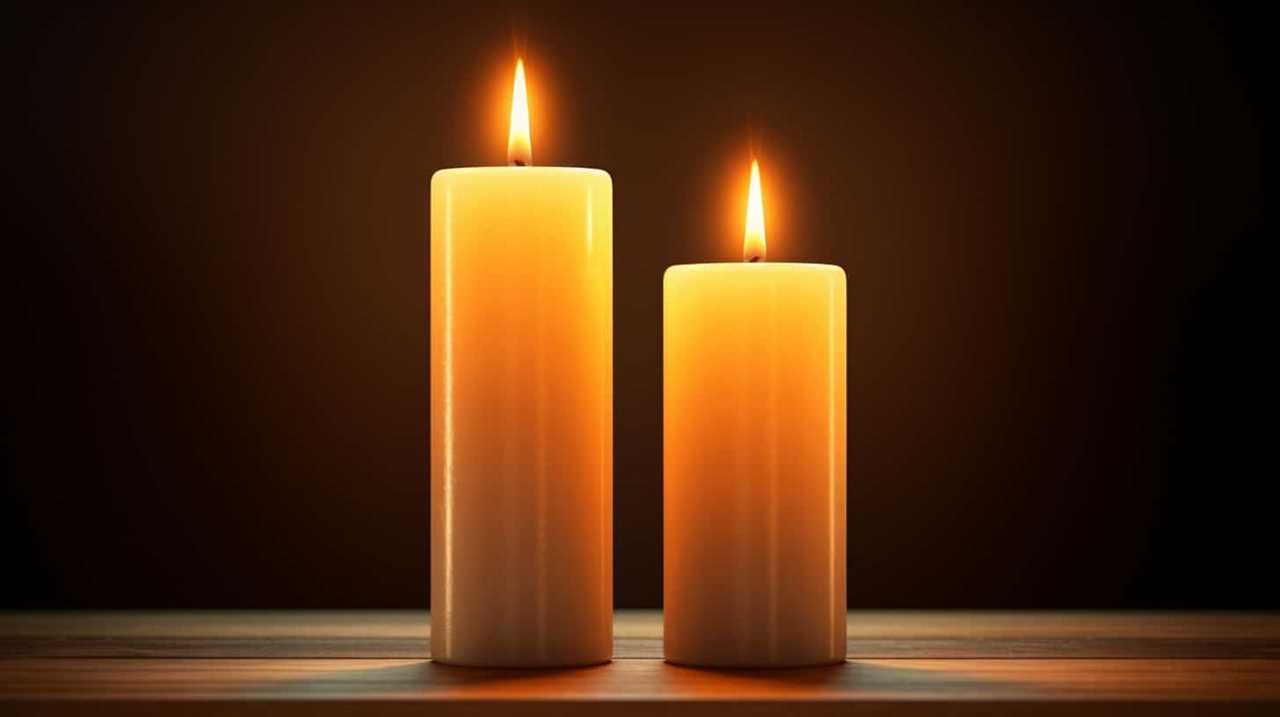
- Play with colors: Experiment with different shades of sand to create beautiful layers that mimic the colors of the ocean and beach.
- Add texture: Incorporate elements like crushed seashells or small pebbles between the layers of sand to add texture and depth to your candle.
- Create patterns: Use a spoon or a small stick to create intricate patterns in the sand layers, such as waves or swirls, to make your sand candle truly unique.
By employing these techniques, you can create beach-themed centerpieces and unique candle holders that will surely impress your guests.
In the next section, we’ll explore fun ways to customize your sand candles, adding a personal touch to your creations.
Fun Ways to Customize Your Sand Candles
As we dive into the topic of customizing sand candles, let’s explore creative ways that will add a personal touch to these unique creations.
When it comes to sand candle centerpieces, the possibilities are endless. You can mix different colors of sand to create beautiful gradients or layer the sand in patterns to create a stunning visual effect.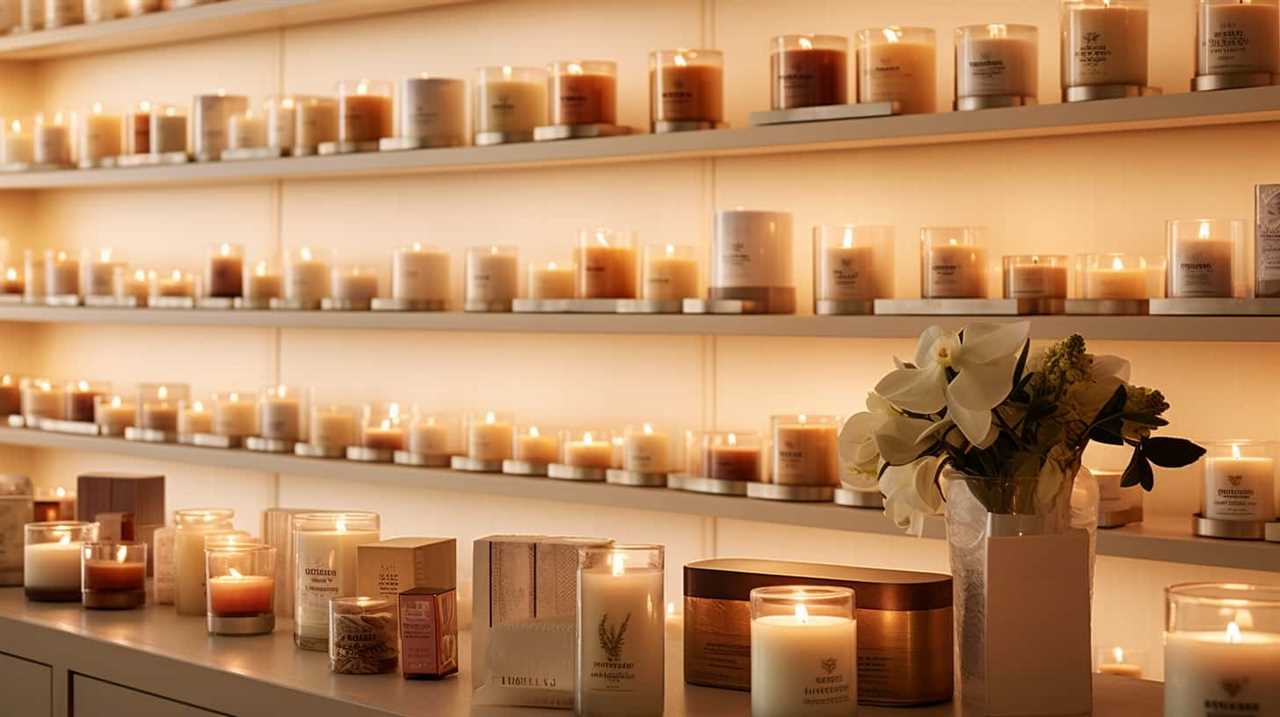
Additionally, consider using unique sand candle molds to add a touch of whimsy or elegance to your candles. From seashells and starfish molds for a beach-themed candle to intricate geometric molds for a modern touch, there are countless options to choose from.
Don’t be afraid to experiment and let your creativity shine through in your customized sand candles.
Frequently Asked Questions
Can Sand Candles Be Used as Functional Candles or Are They Just Decorative?
Sand candles can be used as functional candles, providing a unique and decorative touch to any space. Beginners can learn various techniques to make them, and there are countless creative ways to decorate these beautiful creations.
Are There Any Safety Precautions That Need to Be Taken When Making Sand Candles?
When making sand candles, it’s important to take safety precautions. Make sure to use heat-resistant gloves and goggles. Also, keep a fire extinguisher nearby. The materials required include sand, wax, wicks, and a mold.
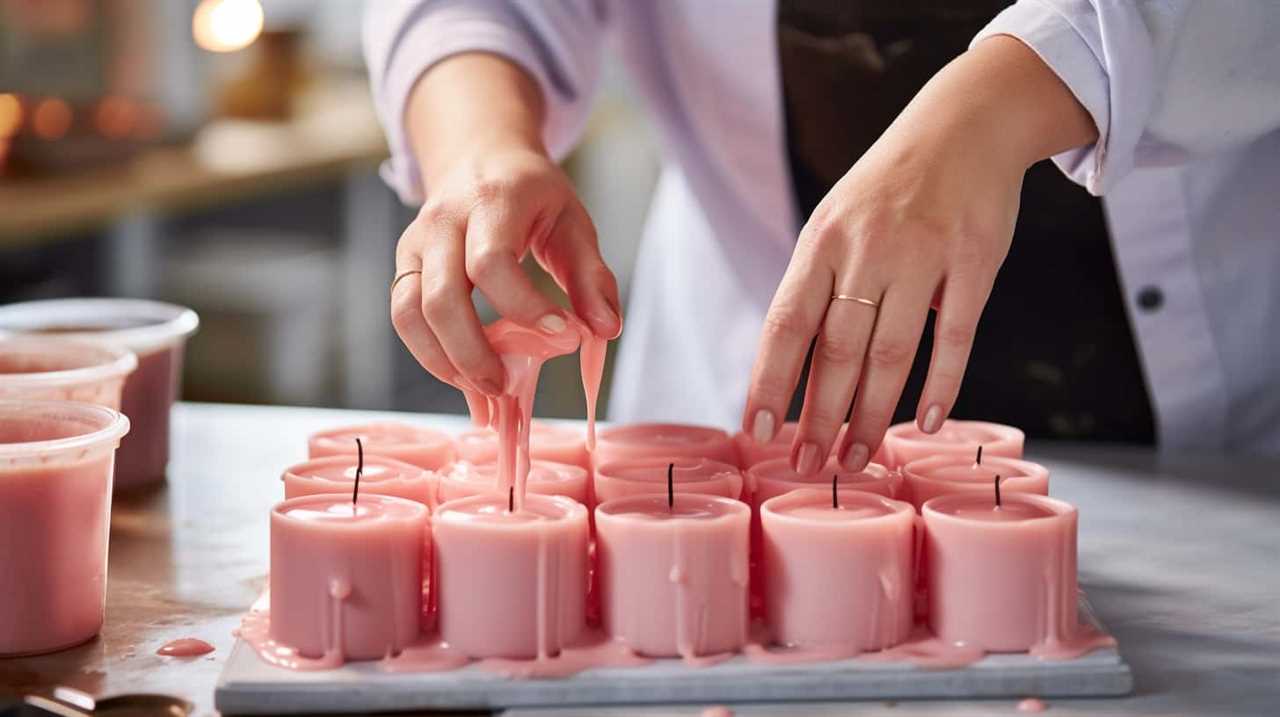
Can Any Type of Sand Be Used to Make Sand Candles or Are There Specific Types That Work Best?
Different types of sand are suitable for making sand candles. While sand from the beach can be used, it is important to remove any impurities or debris. Finer sands tend to work best for creating intricate designs and achieving a smoother finish.
How Long Does It Take for a Sand Candle to Fully Set and Harden?
It usually takes a sand candle a few hours to fully set and harden. To properly care for a sand candle, keep it in a cool, dry place. For added color and fragrance, mix in non-toxic dyes and essential oils.
Can Sand Candles Be Made in Different Shapes and Sizes or Are They Usually Limited to a Specific Form?
Sand candles can be molded into various shapes and sizes, allowing for creative expression. Different techniques, such as using molds or hand sculpting, can be employed to shape these unique candles. Additionally, there are countless ways to decorate them, making each one a work of art.
Conclusion
As the sun sets and the gentle waves crash against the shore, the flickering glow of a sand candle illuminates the beach.
The intricate patterns and vibrant colors dance on the grains of sand, creating a mesmerizing sight.
Crafting a sand candle is an art form that allows you to express your creativity and capture the beauty of the beach.
So, grab some sand, wax, and a sense of adventure, and let your imagination soar as you create your own unique sand candles.
I’m Jane and I love candles. I have candles everywhere in my house–in every room, on every surface. I love the smell of candles, and I love how they make my place feel warm and cozy.
Candles are really important to me. They help me relax and de-stress after a long day. They remind me of happy memories, and they make me feel calm and peaceful. I can’t imagine my life without candles!
-
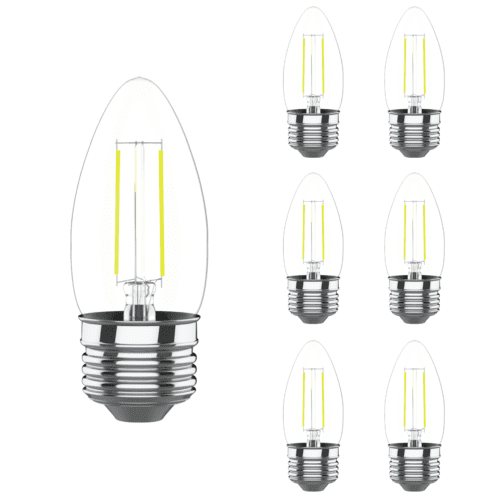
 Beginners Guides1 week ago
Beginners Guides1 week agoThe Similarities of Candle and Light Bulb Lamps
-

 Beginners Guides7 days ago
Beginners Guides7 days agoHow to Determine If Candles Will Melt Outside
-

 Beginners Guides3 months ago
Beginners Guides3 months agoHow To Burn A Candle Without A Wick
-

 Candles3 weeks ago
Candles3 weeks agoHow to Make Scented Candles
-

 Beginners Guides3 weeks ago
Beginners Guides3 weeks agoAre Yankee Candles Vegan?
-

 Beginners Guides3 weeks ago
Beginners Guides3 weeks agoHow to Make Soy Candles
-

 Beginners Guides1 month ago
Beginners Guides1 month agoHow to Make Candles in 5 Easy Steps
-

 Beginners Guides1 week ago
Beginners Guides1 week agoWhy is My Candle Not Sticking to the Glass?








